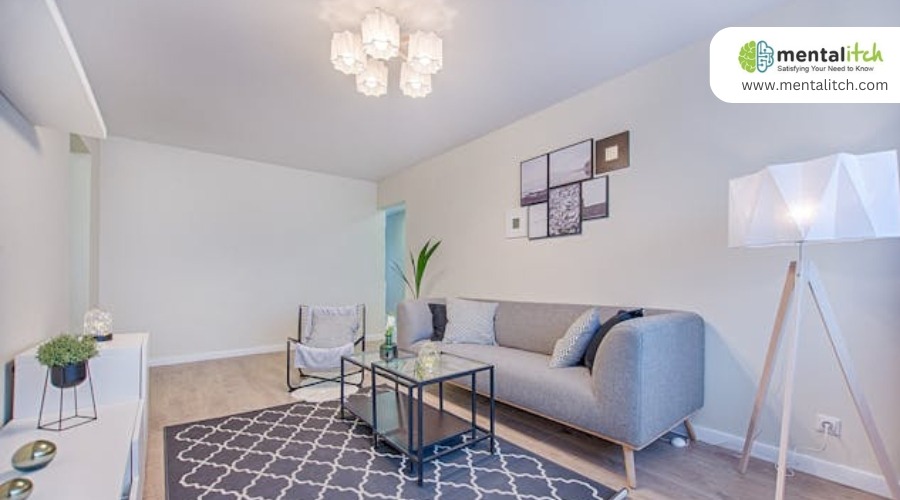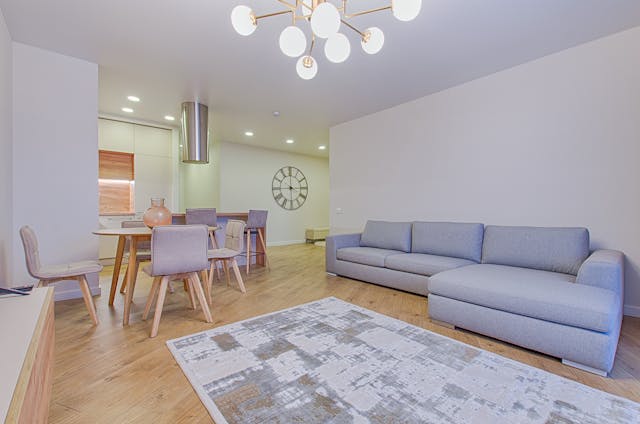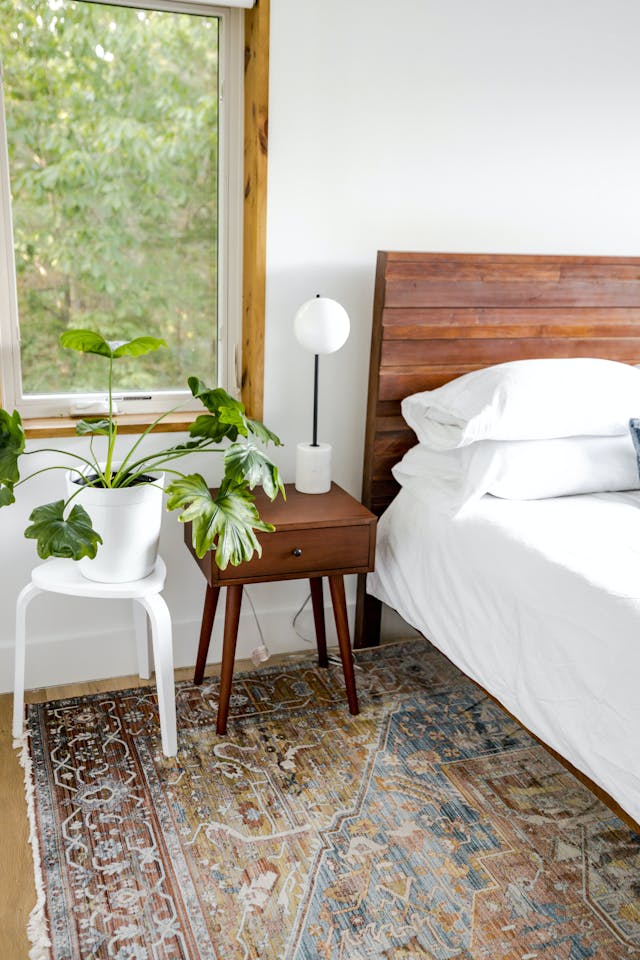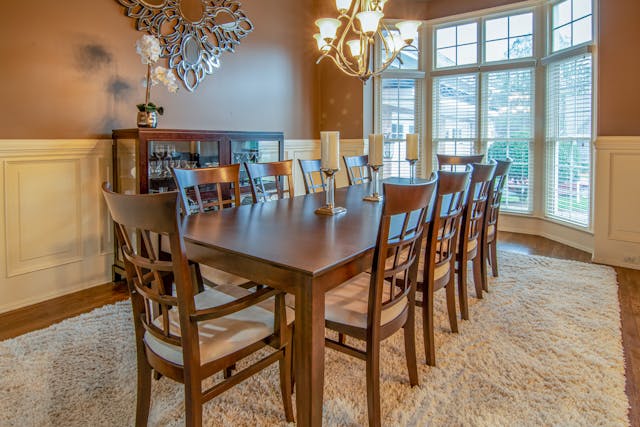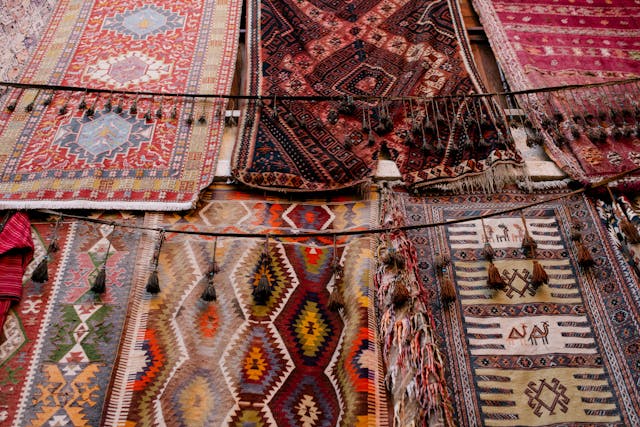Imagine you’ve just acquired a stunning, handwoven rug, intending to transform your living room into a magazine-worthy space. You’re aware of the basics: it should anchor your furniture and tie the room together, but there’s more to it. By choosing the right size, experimenting with layering, and selecting complementary colors and patterns, you can elevate your home’s ambiance. However, the real art lies in the details that most overlook.
Let’s explore how to master these nuances, ensuring your rug not only enhances your space but also reflects your personal style and meets your practical needs.
Selecting the Perfect Rug
Choosing the right rug involves considering the room’s size, layout, and existing decor to ensure a seamless fit and style enhancement. When you’re eyeing that perfect rug for your living room, it’s essential to think about how it’ll complement your area. The color of your rug can significantly impact the room’s overall feel. If your furniture and decor lean towards neutral shades, a brightly colored or patterned rug can add a needed splash of color and vibrancy. On the other hand, if your living room is already full of color, a more subdued rug might help balance the space.
Don’t underestimate the power of a patterned rug to tie your living room’s aesthetic together. Patterns can add depth and interest, making the room appear more dynamic. However, it’s crucial to ensure the pattern complements rather than clashes with your existing decor.
Lastly, investing in a rug pad is a smart move, especially for high-traffic areas. Not only does it add an extra layer of cushioning for comfort, but it also helps protect your rug, extending its life and keeping it looking glamorous. Remember, the right rug can transform your living room, making it a cozy, stylish space that reflects your personal style.
Size and Placement Guidelines
To master the art of rug placement, it’s crucial you select a size that complements your room’s dimensions and furniture arrangement. For a visually balanced look, opt for a rug that allows for at least 18 inches of bare floor around its edges. This guideline not only enhances the room layout but also ensures the space feels open and airy.
When exploring living room rug ideas, consider a large area rug where the front legs of all your furniture pieces sit comfortably on it. This approach ties the space together, creating a cohesive and anchored feel without overwhelming the room.
In dining areas, a rug should extend at least 24 inches beyond the table edges. This size accommodates chairs and avoids any awkward half-on, half-off scenarios. For a bedroom, placing a rug under the lower two-thirds of the bed adds a stylish touch while ensuring it peeks out invitingly.
Living Room Styling Tips
Choosing the right size rug for your living room can make a big difference in how spacious it feels. You’ll want to consider color coordination principles to ensure it complements your existing decor seamlessly. Let’s explore how selecting the perfect rug size and coordinating its color can transform your living room into a stylish and cohesive space.
Rug Size Selection
Selecting the right rug size is key to creating a harmonious and spacious feel in your living room. Here’s how to ensure your rug perfectly complements the space:
- Choose a Rug That’s Large Enough: Your rug should be large enough to fit under all key furniture pieces, extending beyond to define the seating area and make the room appear more spacious.
- Allow for 8-18 Inches of Floor Space**: Opt for a rug size that leaves at least 8-18 inches of bare floor around the edges, creating a balanced look.
- Anchor Your Seating Area**: Select a rug that comfortably accommodates all seating pieces, effectively anchoring the room and tying all elements together for a harmonious living space.
Color Coordination Principles
After considering the size of your rug, it’s crucial to focus on color coordination to enhance your living room’s overall aesthetic. Matching your area rug with the wall color ensures a cohesive look and seamless integration into the space.
Opting for lighter rug colors can create a calm and cozy vibe, inviting relaxation and comfort. Achieving a cohesive feel is about more than just rug and wall colors; it’s also about coordinating your rug with the furnishings and window treatments.
This consistent color coordination ties the room together, promoting unity in your living room’s design. By carefully selecting living room rugs that harmonize with your existing colors, you’ll craft a space that feels thoughtfully curated and welcoming.
Bedroom Rug Ideas
For an instant upgrade to your bedroom’s ambiance, consider adding a beautifully styled rug that extends at least 18-24 inches on each side of the bed, ensuring a balanced and inviting look. This not only enhances the aesthetic of your bedroom but also offers a warm, plush feeling underfoot, perfect for those chilly mornings. Opting for a rug with calming colors like blues or neutrals can significantly contribute to a serene atmosphere, promoting relaxation and peace.
Here are three key tips to keep in mind when selecting the perfect rug for your bedroom:
- Choose the Right Size: Ensure the rug size extends at least 18-24 inches on each side of the bed to maintain a balanced look.
- Opt for Comfort and Durability: A plush, soft rug adds coziness, while materials like wool or synthetic fibers offer durability in high-traffic bedroom areas.
- Experiment with Layering: Layering rugs adds texture and visual interest. Consider placing a smaller, more vibrant rug on top of a larger, neutral one for an eye-catching effect.
Dining Room Rug Placement
Moving on to the dining room, it’s essential you choose the right size rug to complement your space. Consider the material carefully, as it needs to withstand frequent dining chair movement and potential spills. Lastly, finding a style and color that harmonize with your dining room’s aesthetic will pull the whole look together perfectly.
Choosing the Right Size
When selecting a rug for your dining room, it’s crucial to choose one that’s large enough to accommodate all chairs, ensuring they can slide in and out with ease. Achieving a visually appealing and cohesive look hinges on perfect rug placement. Here’s how to nail it:
- Size Matters: Opt for a rug at least a foot or two larger than the dining table. This ensures chairs remain on the rug, avoiding awkward half-on, half-off scenarios.
- Shape Synergy: Pair round tables with a round rug to enhance the table’s shape and maintain a cohesive look.
- Center Stage: Always center the rug under the dining table. This anchors the room and clearly defines the dining area, making the space both functional and aesthetically pleasing.
Material Considerations
After choosing the right size, it’s also critical to select the best material for your dining room rug to ensure durability and ease of maintenance. Consider a durable rug material like wool or polypropylene, known for withstanding high traffic and spills.
Opting for flatweave rugs can make it easier for chairs to move and for the rug to be cleaned, especially important under dining tables. Natural fiber rugs, such as jute or sisal, add texture and warmth while being eco-friendly.
It’s smart to choose a stain-resistant material, like polyester or nylon, to fend off food and drink mishaps. Lastly, look for easy-to-clean options in dining rooms, such as synthetic blends, to keep the area fresh and inviting for every meal.
Style and Color Harmony
Selecting the right rug for your dining room not only enhances the room’s aesthetic but also ties together the furniture and wall colors, creating a harmonious and inviting space. To achieve style harmony and color coordination, follow these guidelines:
- Coordinate rug color with dining room furniture upholstery to create a cohesive look that complements both the living room rugs and dining area.
- Choose a rug size that’s at least a foot or two larger than the dining table to comfortably accommodate dining chairs and define seating areas without overcrowding.
- Opt for a rug color that complements the dining room wall color, ensuring a balanced and inviting atmosphere that adds warmth to your dining space.
Color and Pattern Choices
Choosing the right color and pattern for your rug can dramatically transform the look and feel of any room. For your living room, consider what atmosphere you’re aiming to create. Using bold and vibrant colors in rugs can inject energy and personality, making the space lively and inviting. Alternatively, a neutral rug with subtle patterns can offer a sophisticated and elegant touch, enhancing the room’s overall serenity and class.
Matching the rug colors with your existing furniture upholstery is key to achieving a cohesive and harmonious look. This doesn’t mean everything has to match perfectly, but there should be a sense of balance and unity in your color and pattern choices. Experimenting with unique designs, like geometric patterns or motifs, showcases your personal style while keeping the space dynamic and engaging.
Here’s a quick guide to help you decide:
| For a Vibrant Look | For a Sophisticated Touch |
|---|---|
| Bold patterns | Subtle patterns |
| Vibrant colors | Neutral tones |
| Eye-catching designs | Elegant motifs |
Layering Rugs for Depth
Layering rugs often adds a unique charm and depth to your home’s decor, inviting a blend of textures and patterns that can transform any room. By choosing to layer multiple rugs, you’re not just covering more ground; you’re building a story underfoot that’s as rich in character as any other part of your living space. Whether it’s in the living room or any other area, this approach can significantly enhance coziness and create a focal point that draws the eye.
Here are three key strategies to remember when layering rugs for depth:
- Start with a Solid Foundation: Begin with a larger, neutral rug like jute to ground the space. This rug adds not only texture but also a versatile backdrop for more decorative top layers.
- Mix Textures and Patterns: Combining different textures and patterns adds visual interest and personality. Ensure there’s a common color or theme to maintain a cohesive design.
- Overlap Strategically: Place smaller rugs on top in a way that they overlap slightly. This technique helps to create a focal point and unify the layered look, making the space feel thoughtfully curated rather than cluttered.
Care and Maintenance
After exploring the artistic approach of layering rugs, it’s crucial to focus on their care and maintenance to ensure they remain beautiful and durable over time. Whether you’ve chosen a vibrant or neutral color scheme for your living room, the right care for your area rugs can make all the difference.
Regular vacuuming is essential, not just for cleanliness but also to prevent wear and tear. Spills should be blotted immediately with a clean cloth and mild detergent, preventing stains from setting in and ruining the aesthetic you’ve worked hard to achieve.
Professional cleaning every 1-2 years is a must to deeply clean your rugs, extending their lifespan and keeping them looking as fresh as the day you laid them down. Between professional cleanings, rotating your rugs is a simple yet effective way to ensure even wear, especially in high-traffic areas of your living room.
Moreover, using furniture pads under heavy pieces can prevent unsightly indentations and protect the rug fibers from damage. Lastly, be mindful of placing rugs in areas that receive direct sunlight; prolonged exposure can lead to fading. Periodically rotating your rugs can also mitigate this effect, keeping your living space vibrant and welcoming.
Rug Trends to Follow
Diving into the latest rug trends, you’ll find that bold colors like blues and purples are transforming living spaces with a dramatic flair. This shift isn’t only about adding a pop of color but also about injecting personality and vibrancy into your living room. Area rugs, in particular, have become the focal point, offering a blend of contemporary design and comfort.
To keep you ahead of the curve, here are three key trends to embrace:
- Natural Materials: Rugs made from natural fibers aren’t just trending; they’re becoming a staple. Their durability and versatility make them ideal for any room, ensuring your living space stays both stylish and sustainable.
- Artistic Incorporation: Think of your area rug as a piece of art for your floor. This trend involves choosing rugs with unique designs, patterns, or textures that stand out, adding a layer of personality and color to your living room.
- Modernizing Country Style: Incorporating vibrant rugs into minimalist living rooms is a clever way to modernize country style. This approach brings warmth and a contemporary feel, perfectly blending tradition with modern design.
Additional Details
- Learn how a round rug can add a contemporary look
- Also check out luxury bedroom ideas
Conclusion
In wrapping up, styling your home with the right rugs isn’t just about choosing beautiful patterns or colors. It’s about creating a cohesive, comfortable space that reflects your style. Remember, the perfect rug can transform a room, so focus on size, placement, and how it complements your decor. Don’t shy away from layering for depth or experimenting with trends. With regular care, your rugs will remain a stunning part of your home for years.
Happy decorating!

